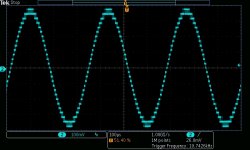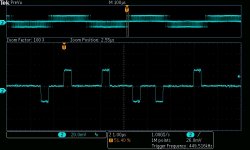Dac chip hardly matters and you didn't indicate if you want DSD (seems like everybody wants it now) If not and you want a nice analog stage with good discrete volume control and a remote, used Antelope Zodiac Gold can be bought for around $1000. It is a good, slick product , plays 384khz PCM through USB , enough in and outs , sounds good enough and unlike DIY, chinese DACs has some resale value too. It is a High End dac designed by people who are capable of coming up with original ideas and are not only
"copy and paste" electricians.
"copy and paste" electricians.
Given that with only one sentence You have just eliminated 99% of the present audio market..
That isn't true. Yes, lots of delta-sigmas indeed, but none of the really great dacs i have had the pleasure to audition were delta-sigma. Which is still besides the point.
My claim is only that using real-time software conversion and a powerful PC sounds really bad to me. For a number of reasons i would imagine, but even those are unimportant as at the end sound quality is based on a subjective perception.
My experience with pc sources has led me to believe that a low-power consumption processor, powered from a clean linear supply with as many linear regulators as the MB design will allow for is the route to better pc sound. Even better if there are separate server and NAA device of extremely low power.
Of course such a setup is not suitable for real time conversion, so the only time when i did such comparisons in my own system was with a real power house PC and a T+A DAC 8. Perhaps this particular dac is not the best test device as the pcm part is just average, while the dsd part is really well designed. The hqplayer upconversion sounded perhaps less digital and more like a caricature of analogue. It was dramatically different to what native high rate dsd sounded in the same setup.
Unfortunately never tried off-line conversion and i wish i had.
My opinion only. Everyone is free to like whatever sound pleases them.
There are a lot of DACs to choose from out there. Most of them have little or no measured performance data. Most of them haven't been reviewed by Stereophile who seem to do fairly comprehensive evaluations: Recommended Components: 2017 Edition Digital Processors | Stereophile.com
What are you going to do?
What are you going to do?
Yes, true. Was talking more in general. SD..
That's not necessarily a good comparison, because single-bit sigma-delta modulators have their specific technical advantage and disadvantages compared to multi-bit sigma-delta modulators/noise shapers. The advantage is that there are no matching requirements, the disadvantages that you can't dither them properly (*), which can lead to idle tone issues, the huge amount of out-of-band noise that needs to be filtered off and for continuous-time implementations without FIRDAC that they need a very good clock because of their jitter sensitivity.
If someone dislikes their disadvantages enough, expectation bias can easily lead to a poor subjective performance - or maybe some can even really hear a difference, who knows?
(*) You can dither them to some extent, but you can't dither them according to nonsubtractive dither theory.
Last edited:
Many DSM DACs uses a multi-bit architecture like 6bit. But in fact, they usually don't operate or can't in 6bit resolution. The first pic is at -1dBFS where the DAC can utilize the maximum resolution. You can count 27 levels because this is a 5bit resolution DAC. The second is at -32dBFS where the DAC can only use three values,+1LSB, zero and -1LSB. I love to listen to classical music which has pianissimo probably less than -40DBFS. It means my DSM DAC with 5bit resolution averagely operates in two or three resolution for classical music. Every DSM DACs must use three levels operation in small amplitude. I'm sure this is interesting and true but not well known.
Attachments
@xx3stksm ...
Hmmm ... very interesting observation - thanks for sharing. It reminds me of some years ago I had a conversation with a person who had been one of the main designers of a very well regarded ES9018 based DAC. He said that the ES9018 IC itself "chipped" (sampled) at 1.536 MHz at a relatively low resolution (6 bits or 9 bits - I don't remember exactly) and retrospectively in his experience/assessment this seemed to lead to degrees of listening fatigue.
Also, to this end, I personally have a PCM1794 based DAC which (again to my memory) operates as a multi-bit up to 6 bits and then switches to a DS structure on the lesser bits. When looking at the oscilloscope output traces of the PCM1794 (it should be noted that it is a DDDAC variant, i.e. the ICs internal digital filters have been disabled) it often looks sort of "squared" - like a few major steps with "minor" steps added on the top ... I hope this makes sense ... ? It puzzled me when I saw it but I chose to assume that it was supposed to be combined with filtering and in this way it would ad up to the adequate curve-shapes. But maybe it doesn't?
Just thinking aloud here (and not being an expert on digital signal theory!): Maybe this could to some degree explain why pure DSD converters & PCM converters appear to be highly regarded for their musicality/purity ...
Anyone knows how the AK4497 samples?
Cheers,
Jesper
Many DSM DACs uses a multi-bit architecture like 6bit. But in fact, they usually don't operate or can't in 6bit resolution. The first pic is at -1dBFS where the DAC can utilize the maximum resolution. You can count 27 levels because this is a 5bit resolution DAC. The second is at -32dBFS where the DAC can only use three values,+1LSB, zero and -1LSB. I love to listen to classical music which has pianissimo probably less than -40DBFS. It means my DSM DAC with 5bit resolution averagely operates in two or three resolution for classical music. Every DSM DACs must use three levels operation in small amplitude. I'm sure this is interesting and true but not well known.
Hmmm ... very interesting observation - thanks for sharing. It reminds me of some years ago I had a conversation with a person who had been one of the main designers of a very well regarded ES9018 based DAC. He said that the ES9018 IC itself "chipped" (sampled) at 1.536 MHz at a relatively low resolution (6 bits or 9 bits - I don't remember exactly) and retrospectively in his experience/assessment this seemed to lead to degrees of listening fatigue.
Also, to this end, I personally have a PCM1794 based DAC which (again to my memory) operates as a multi-bit up to 6 bits and then switches to a DS structure on the lesser bits. When looking at the oscilloscope output traces of the PCM1794 (it should be noted that it is a DDDAC variant, i.e. the ICs internal digital filters have been disabled) it often looks sort of "squared" - like a few major steps with "minor" steps added on the top ... I hope this makes sense ... ? It puzzled me when I saw it but I chose to assume that it was supposed to be combined with filtering and in this way it would ad up to the adequate curve-shapes. But maybe it doesn't?
Just thinking aloud here (and not being an expert on digital signal theory!): Maybe this could to some degree explain why pure DSD converters & PCM converters appear to be highly regarded for their musicality/purity ...
Anyone knows how the AK4497 samples?
Cheers,
Jesper
curious to know which kit board u used- want to try an external dac w my Node 2I’ve been enjoying my ak4495SEQ on a kit board, using an Xmos usb input, but am next going to try and ditch the pc altogether. My plan is to try an SD card player with a low noise power supply. This will be all inside a case, with a pre amp as well.
I’m using this board;
Assembled XMOS U8+AK4495SEQ+AD827 DAC USB Decoder Board 4700UF/35V 32BIT 768K 6010848613731 | eBay
I don’t know what you have available for outputs from your player, I am using the 12s out from an sd card reader board now with mine. You may need to find a board or dac that has a coaxial input if that’s what you have to work with. The 12s may be there on your player, just not sure how much hacking you are up to either!
Assembled XMOS U8+AK4495SEQ+AD827 DAC USB Decoder Board 4700UF/35V 32BIT 768K 6010848613731 | eBay
I don’t know what you have available for outputs from your player, I am using the 12s out from an sd card reader board now with mine. You may need to find a board or dac that has a coaxial input if that’s what you have to work with. The 12s may be there on your player, just not sure how much hacking you are up to either!
- Status
- This old topic is closed. If you want to reopen this topic, contact a moderator using the "Report Post" button.
- Home
- Source & Line
- Digital Line Level
- Best DAC-chip out there?

